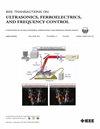Remote Super-Resolution Mapping of Wave Fields
IF 3
2区 工程技术
Q1 ACOUSTICS
IEEE transactions on ultrasonics, ferroelectrics, and frequency control
Pub Date : 2025-02-04
DOI:10.1109/TUFFC.2025.3538607
引用次数: 0
Abstract
Mapping wave field in space has many applications such as optimizing design of radio antennas, improving and developing ultrasound transducers, and planning and monitoring the treatment of tumors using high-intensity focused ultrasound (HIFU). Currently, there are methods that can map wave fields remotely or locally. However, there are limitations to these methods. For example, when mapping the wave fields remotely, the spatial resolution is limited due to a poor diffraction-limited resolution of the receiver, especially when the f-number of the receiver is large. To map the wave fields locally, the receiver is either subject to damage in hazardous environments (corrosive media, high temperature, high wave intensity, and so on) or difficult to be placed inside an object. To address these limitations, in this article, the point spread function (PSF)-modulation super-resolution imaging method was applied to map pulse ultrasound wave fields remotely at a high spatial resolution, overcoming the diffraction limit of a focused receiver. For example, to map a pulse ultrasound field of a full-width-at-half-maximum (FWHM) beamwidth of 1.24 mm at the focal distance of a transmitter, the FWHM beamwidths of the super-resolution mapping of the pulse wave field with a spherical glass modulator of 0.7 mm diameter at two receiver angles (0° and 45°) were about 1.13 and 1.22 mm, respectively, which were close to the theoretical value of 1.24 mm and were much smaller than the diffraction-limited resolution (1.81 mm) of the receiver. Without using the super-resolution method to remotely map the same pulse wave field, the FWHM beamwidth was about 2.06 mm. For comparison, the FWHM beamwidth obtained with a broadband (1–20 MHz) and 0.6-mm-diameter polyvinylidene fluoride (PVDF) needle hydrophone was about 1.41 mm. In addition to the focused pulse ultrasound wave field, a pulse Bessel beam near the transducer surface was mapped remotely with the super-resolution method, which revealed high spatial frequency components of the beam.波场的远程超分辨率映射。
空间波场测绘在无线电天线的优化设计、超声换能器的改进和发展、高强度聚焦超声(HIFU)治疗肿瘤的规划和监测等方面有着广泛的应用。目前,有一些方法可以远程或局部绘制波场。然而,这些方法也有局限性。例如,在远程绘制波场时,由于接收器的衍射限制分辨率较差,特别是当接收器的f数较大时,空间分辨率受到限制。为了在局部绘制波场,接收器要么在危险环境(腐蚀性介质、高温和高波强度等)中受到损坏,要么难以放置在物体内部。为了解决这些限制,本文采用psf调制超分辨率成像方法(January, 2024 IEEE TUFFC),克服聚焦接收器的衍射极限,以高空间分辨率远程绘制脉冲超声波场。例如,映射一个脉冲超声场的半宽度(应用波束宽度的1.24毫米焦距发射机,应用波束宽度的脉冲波场的超分辨率映射与0.7毫米直径的球形玻璃调制器在两个接收器角度(0°和45°)分别是1.13毫米和1.22毫米,接近理论值的1.24毫米,远小于衍射极限分辨率(1.81毫米)的接收器。在不使用超分辨率方法远程映射同一脉冲波场的情况下,FWHM波束宽度约为2.06 mm。相比之下,宽带(1-20 MHz)和直径0.6 mm的聚偏氟乙烯(PVDF)针形水听器获得的FWHM波束宽度约为1.41 mm。除了聚焦的脉冲超声波场外,利用超分辨率方法远程测绘了传感器表面附近的脉冲贝塞尔光束,揭示了光束的高空间频率成分。
本文章由计算机程序翻译,如有差异,请以英文原文为准。
求助全文
约1分钟内获得全文
求助全文
来源期刊
CiteScore
7.70
自引率
16.70%
发文量
583
审稿时长
4.5 months
期刊介绍:
IEEE Transactions on Ultrasonics, Ferroelectrics and Frequency Control includes the theory, technology, materials, and applications relating to: (1) the generation, transmission, and detection of ultrasonic waves and related phenomena; (2) medical ultrasound, including hyperthermia, bioeffects, tissue characterization and imaging; (3) ferroelectric, piezoelectric, and piezomagnetic materials, including crystals, polycrystalline solids, films, polymers, and composites; (4) frequency control, timing and time distribution, including crystal oscillators and other means of classical frequency control, and atomic, molecular and laser frequency control standards. Areas of interest range from fundamental studies to the design and/or applications of devices and systems.

 求助内容:
求助内容: 应助结果提醒方式:
应助结果提醒方式:


